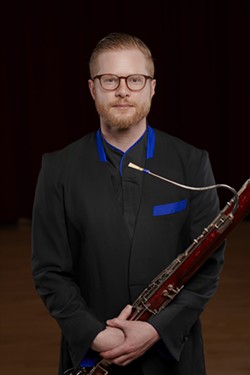Classical Couture

Sitting in cushioned seats in spacious, gloriously decorated halls, it is easy to forget that classical performances are incredibly physically demanding. That illusion results, in part, from the fact that everyone onstage seems dressed for a fancy party. For centuries, symphony musicians have been athletes in formal wear.
That changes this weekend for the Richmond Symphony, who will be wearing new outfits that, while still evoking the past, incorporate state-of-the-art fashion designs utilizing global sourcing of materials, bioengineered nanotechnology, and artificial intelligence tailoring.
“This is something few orchestras in the world are daring to do,” said Artistic Director Valentina Peleggi at a Carpenter Center event this week unveiling the new clothing. “The symphonic world is well known to be very traditional. We do not want to break with that, but to include innovation. Black is the traditional color of the costume we always wear. One hundred years ago, the people in the audience were [in black] too. Now they come in comfortable clothes, and [what we wear] is incredibly uncomfortable.”
Their new garments are still mostly black, with elegant formal lines, but enlivened with bright flashes of sapphire blue. The color evokes the James River, echoing the waveforms in the Richmond Symphony logo. “We want to be recognizable as a group,” says Peleggi. “Whether you go to the concert or you watch it on YouTube, you can tell it is the Richmond Symphony.”
-
Peter McElhinney
- From left: Catherine Schuller of Catherine Schuller Enterprises, Lacey Huszcza, executive director of RSO, Lauren Solomon of SnappConnor public relations, and Valentina Peleggi, music director for RSO.
The splashes of color are obvious, the innovations less so. The fabric is incredibly light and hidden buttons avoid otherwise inevitable snags. Panels of stretching fabric are strategically positioned behind the arms, invisibly providing enhanced freedom of movement. “We have to look smart,” says Peleggi, “but we also have to move. I need something that lets me make big gestures without ripping a seam. I do not want to keep my arms down when I am conducting because I am worried about breaking my jacket. And it is not just me; each instrument is different. Violin players and flute players need to move in specific ways. The garment needs to reflect that.”
There are other logistical considerations. “We travel frequently, so we need something that is light, washes easily and does not wrinkle. I do not want to spend an hour before a concert ironing.” And there are the biological implications of intense exertion — people sweat. “If we have three concerts in a row, clothes’ are going to start to smell. That is just how it is,” Peleggi says.
Renowned image consultant Lauren Solomon led the project. The baseline was a similar effort conducted by the Baltimore Symphony a decade ago. “For us, it was a very different attempt,” Solomon explains. “So much has happened since 2012. Back then, ‘athleisure’ did not exist. Now everyone knows what it is to be comfortable. So much has happened with blending fabrics. Something without an elastic waistband? We are never going back to that.”
The work may have started with New York fashion experts, but it quickly expanded across the country and beyond, notably to Tafa Jara Couture, a design and fabrication house in Dakar, the capital of Senegal. “We were able to find elegant, beautiful performance fabrics that would fit our budget- which, by the way, was a thing,” says Solomon.
The nanoparticle, anti-bacterial treatment came from came from FUZE Biotech. According to their website, they deliver “permanent, chemical-free technology that can be applied to any surface or textile to prevent and protect against odor causing bacteria and mold. Dedicated to sustainability, only a small amount of FUZE is applied during a light misting process at either the factory or the consumer level, causing no harmful effects to [the user] or the environment.” Designed to last through the lifetime of the garment, it reduced the need for washing, with associated eco benefits.
Artificial intelligence systems from Human Solutions in North Carolina automated the fitting. Using a portable analogue to an airport full body scanner, their technology created accurate models of every musician, incorporating custom tailoring in the manufacturing process.
These well-thought out new outfits will debut with the Saturday, April 1 performance of Mahler’s 2nd “Resurrection” Symphony. It is an ideal choice, given that the expansive score requires the entire company, a full choir, and a host of additional musicians.
“We have been incredibly fortunate to really do something that brings [classical traditions] into the technological future,” says Solomon. “We’ve really done everything we could to present something new and fresh that harkens back to the past, but still represents the progressive future of the Richmond Symphony.”
A tradition-bound past artfully refashioned into something materially more flexible, responsible, and inclusive? That is Richmond’s brand.




